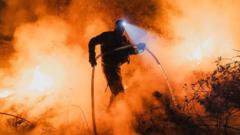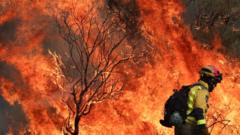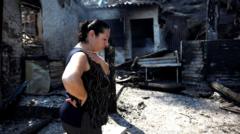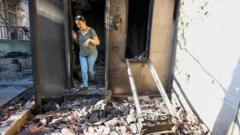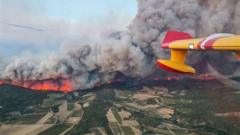Air quality in states like Michigan, Wisconsin, and Minnesota has been severely impacted, raising concerns for vulnerable populations.
Smoke from Canadian Wildfires Poses Health Risks in Upper Midwest
Smoke from Canadian Wildfires Poses Health Risks in Upper Midwest
Smoke from recent wildfires in Canada is drifting into the Upper Midwest, prompting health warnings and air quality advisories across several states.
In recent days, significant smoke from active wildfires in Canada has begun to infiltrate the Upper Midwest of the United States. Authorities have responded by issuing air quality advisories concerning particulate pollution across Michigan, Wisconsin, and Minnesota. Affected residents, particularly those in sensitive groups—such as individuals with heart or lung conditions, older adults, children, pregnant individuals, and outdoor workers—are urged to limit outdoor activities during this period.
In Michigan, officials from the Department of Environment, Great Lakes and Energy reported elevated levels of fine particulates in the air, with these poor air quality conditions expected to persist through Saturday morning. The fine particulates, tiny particles made up of soot, ash, and dust, can be carried across vast distances by winds and were detected traveling from as far away as Manitoba in Canada.
As the wildfire season typically spans from March to October in Canada, southern provinces often experience an increase in fire activity during May. This month has already seen tragic incidents, including the deaths of two people and the evacuation of an entire town in Manitoba due to a raging wildfire.
The smoke has crossed into states like Minnesota, where the pollution readings have trended towards "red" on the air quality index, indicating unhealthy conditions for a significant portion of the population. Minnesota's Pollution Control Agency announced that this smoke event may extend over several days, with the highest concentration expected until Saturday afternoon, followed by additional smoke expected to arrive on Sunday and Monday.
Wisconsin officials reported that hazy skies and worsening air quality from the Canadian wildfires are anticipated to impact the northwestern portion of the state, with the advisory set to expire early Saturday. However, the ongoing situation may warrant further air quality alerts depending on how conditions evolve. Reports indicate that air quality may continue to fluctuate between "orange" and "red," signifying unhealthy conditions for both sensitive groups and the general public.
In Michigan, officials from the Department of Environment, Great Lakes and Energy reported elevated levels of fine particulates in the air, with these poor air quality conditions expected to persist through Saturday morning. The fine particulates, tiny particles made up of soot, ash, and dust, can be carried across vast distances by winds and were detected traveling from as far away as Manitoba in Canada.
As the wildfire season typically spans from March to October in Canada, southern provinces often experience an increase in fire activity during May. This month has already seen tragic incidents, including the deaths of two people and the evacuation of an entire town in Manitoba due to a raging wildfire.
The smoke has crossed into states like Minnesota, where the pollution readings have trended towards "red" on the air quality index, indicating unhealthy conditions for a significant portion of the population. Minnesota's Pollution Control Agency announced that this smoke event may extend over several days, with the highest concentration expected until Saturday afternoon, followed by additional smoke expected to arrive on Sunday and Monday.
Wisconsin officials reported that hazy skies and worsening air quality from the Canadian wildfires are anticipated to impact the northwestern portion of the state, with the advisory set to expire early Saturday. However, the ongoing situation may warrant further air quality alerts depending on how conditions evolve. Reports indicate that air quality may continue to fluctuate between "orange" and "red," signifying unhealthy conditions for both sensitive groups and the general public.


